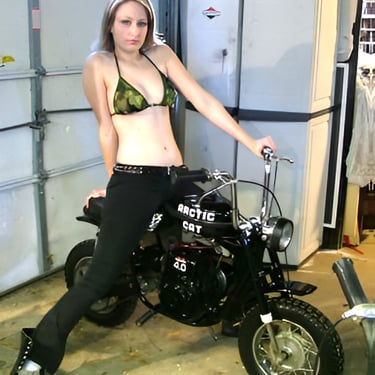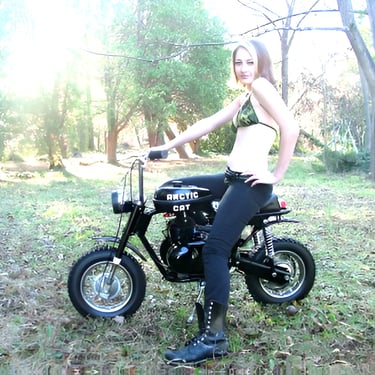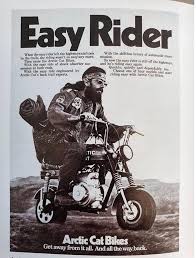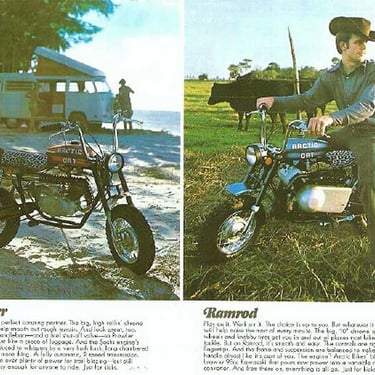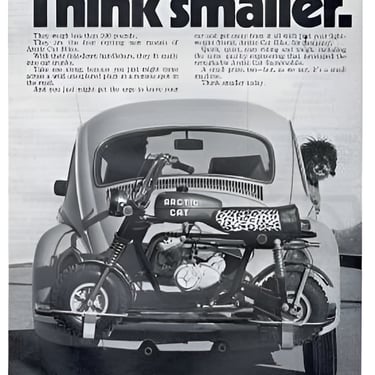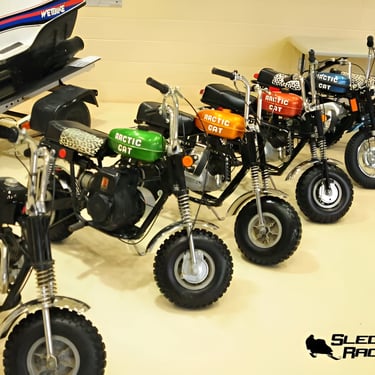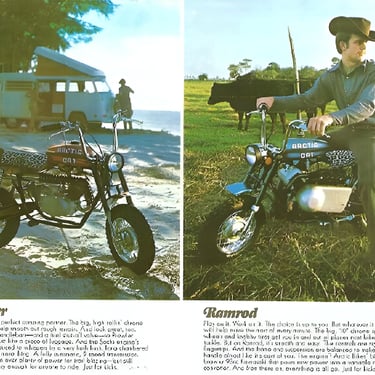Arctic Cat Mini Bikes: A Brief but Impactful Era
Arctic Cat, known for snowmobiles and ATVs, ventured into the mini bike market from 1970 to 1972. Despite the short production run, these mini bikes made a significant impact, featuring unique designs and names like SSSCAT, Climber, and Screamer. They were well-received for their adaptability and performance on various terrains, becoming sought-after collectibles today. Arctic Cat's brief foray into mini bikes demonstrated their ability to diversify and innovate, leaving a lasting legacy among enthusiasts.
1970'SFOUR STROKEUNITED STATES MINI-BIKESARCTIC CAT
10/1/20247 min read
Arctic Cat Mini Bikes: A Brief but Impactful Era
Introduction
Arctic Cat, a name synonymous with snowmobiles and all-terrain vehicles, once ventured into the world of mini bikes during the early 1970s. This brief but significant foray into the booming minibike market left an indelible mark on the company's history and the memories of many enthusiasts. Arctic Cat mini bikes, produced from 1970 to 1972, captured the imagination of young riders with their rugged design and playful names. These compact two-wheelers represented a unique chapter in Arctic Cat's diverse product lineup, showcasing the company's ability to adapt to market trends and deliver exciting vehicles beyond their winter sports expertise.
History of Arctic Cat Mini Bikes
Arctic Cat's venture into the mini bike market was a brief but notable period in the company's history. Founded in 1960 by Edgar Hetteen in Thief River Falls, Minnesota, Arctic Cat had already established itself as a prominent snowmobile manufacturer by the late 1960s.
In 1970, recognizing the growing popularity of mini bikes, Arctic Cat decided to diversify its product line and tap into this booming market. This decision aligned with the company's ethos of providing exciting recreational vehicles, extending their reach beyond winter sports.
The mini bike production ran from 1970 to 1972, a relatively short period that coincided with the peak of the mini bike craze in the United States. During these years, Arctic Cat produced several models, each with unique characteristics and evocative names that appealed to young riders and enthusiasts.
While the exact reasons for Arctic Cat's exit from the mini bike market in 1972 are not widely documented, it's likely that changing market conditions, increased competition, and a desire to focus on their core snowmobile business played roles in this decision. Despite the brief production run, Arctic Cat mini bikes left a lasting impression on the mini bike community and remain sought-after collectibles today.
This foray into mini bikes demonstrated Arctic Cat's adaptability and willingness to explore new markets, traits that would continue to define the company in the decades to come.
Notable Arctic Cat Mini Bike Models
During their brief production run from 1970 to 1972, Arctic Cat introduced several mini bike models, each with its own unique characteristics and appealing names. Here are some of the most notable Arctic Cat mini bike models:
SSSCAT I and SSSCAT II (1970):
These were among the first mini bike models introduced by Arctic Cat.
The "SSS" likely stood for "Super Sport Special" or something similar, emphasizing their sporty nature.
Climber (1971):
As the name suggests, this model was likely designed for tackling inclines and rough terrain.
It featured a Tecumseh H50 engine, making it suitable for more challenging rides.
Prowler (1971-1972):
One of the more popular models, the Prowler was produced in both 1971 and 1972.
It was known for its rugged design and reliable performance.
Screamer (1971):
With a name like "Screamer," this model was likely one of the more performance-oriented offerings.
It appealed to riders looking for speed and excitement.
Whisker (1971):
The Whisker was another playfully named model in the Arctic Cat lineup.
It was designed to be an accessible and fun ride for younger enthusiasts.
Scout (1972):
Introduced in the final year of Arctic Cat's mini bike production.
The Scout was likely positioned as an entry-level or all-around model.
Each of these models showcased Arctic Cat's commitment to producing diverse and exciting mini bikes. The creative naming conventions and varied designs helped Arctic Cat stand out in the competitive mini bike market of the early 1970s. Today, these models are highly sought after by collectors and enthusiasts, serving as reminders of Arctic Cat's brief but impactful presence in the mini bike world.
Technical Specifications and Features
Arctic Cat mini bikes, while varying across models, shared some common technical specifications and features that defined their performance and appeal. Here's an overview of the general characteristics found in Arctic Cat mini bikes:
Engines:
Most models were equipped with small displacement engines, typically ranging from 47cc to 50cc.
Tecumseh engines were commonly used, such as the H50 model found in the Climber.
Some models may have used Sachs engines, known for their reliability in small vehicles.
Frame and Suspension:
Sturdy tubular steel frames were standard, providing durability for off-road use.
Basic suspension systems, often including front forks and a rigid rear, were typical of mini bikes of the era.
Transmission:
Most models featured a centrifugal clutch for easy operation.
Single-speed transmissions were common, though some models may have had multiple gears.
Brakes:
Drum brakes were standard, typically on the rear wheel.
Some models may have featured front brakes for additional stopping power.
Tires:
Knobby tires were often used to provide traction on various terrains.
Wheel sizes were generally small, fitting the mini bike profile.
Additional Features:
Many models included a padded seat for rider comfort.
Simple instrumentation, if any, was typical.
Some models featured protective elements like fenders and chain guards.
While specific details for each model are limited, these general specifications provide insight into the design philosophy of Arctic Cat mini bikes. The focus was on creating sturdy, easy-to-ride vehicles that could handle a variety of terrains while remaining accessible to young or novice riders.
Performance and Handling
Arctic Cat mini bikes, despite their small size, were designed to deliver an engaging and capable riding experience. Their performance and handling characteristics made them popular among young riders and enthusiasts. Here's an overview of how these mini bikes performed:
Engine Performance:
The small displacement engines (47-50cc) provided adequate power for their size and weight.
Top speeds typically ranged from 20 to 30 mph, depending on the model and terrain.
Quick acceleration was a hallmark of these nimble machines, especially from a standing start.
Handling:
The compact wheelbase and low center of gravity contributed to agile handling.
Maneuverability was a strong point, allowing riders to navigate tight spaces and trails easily.
The knobby tires provided good traction on various surfaces, from dirt paths to grassy fields.
Terrain Adaptability:
Models like the Climber were specifically designed for tackling inclines and rough terrain.
The sturdy frame construction allowed these mini bikes to handle bumps and jumps with relative ease.
Ride Comfort:
Basic suspension systems offered some cushioning against bumps and vibrations.
Padded seats provided a degree of comfort for longer rides.
Braking:
The drum brake systems, while basic, were generally adequate for the speeds these bikes could achieve.
Stopping distances were reasonable, given the bikes' light weight and moderate top speeds.
User-Friendliness:
The centrifugal clutch system made these bikes easy to operate, even for novice riders.
Simple controls and straightforward operation contributed to a user-friendly riding experience.
While not designed for high-speed or long-distance riding, Arctic Cat mini bikes excelled in providing a fun, accessible off-road experience. Their performance characteristics were well-suited to their intended use: recreational riding on varied terrain, often by younger or less experienced riders. The combination of peppy engines, agile handling, and rugged construction made Arctic Cat mini bikes capable performers in their class.
Market Reception and Legacy
Arctic Cat's entry into the mini bike market in the early 1970s was met with enthusiasm from young riders and off-road enthusiasts. Despite their relatively short production run, these mini bikes left a lasting impression on the recreational vehicle landscape.
Market Reception:
Arctic Cat mini bikes were well-received during their production years, capitalizing on the mini bike craze of the late 1960s and early 1970s.
The brand's reputation in snowmobiles likely contributed to the initial interest in their mini bike offerings.
Creative model names like "Prowler," "Screamer," and "Whisker" appealed to the target demographic of young, adventure-seeking riders.
Competition:
Arctic Cat competed with established mini bike manufacturers like Rupp, Taco, and Fox, as well as offerings from traditional motorcycle companies.
The unique styling and Arctic Cat brand recognition helped these models stand out in a crowded market.
Legacy:
Although production ceased in 1972, Arctic Cat mini bikes have maintained a dedicated following among vintage mini bike enthusiasts.
These models are now considered collectibles, with restored examples commanding attention at vintage vehicle shows and auctions.
The brief foray into mini bikes demonstrates Arctic Cat's adaptability and willingness to explore diverse product lines.
Impact on Arctic Cat:
While the company returned its focus to snowmobiles and later ATVs, the mini bike experience likely informed future product development strategies.
The engineering and marketing insights gained from the mini bike venture may have contributed to Arctic Cat's continued success in recreational vehicles.
Nostalgia Factor:
For many riders who grew up in the early 1970s, Arctic Cat mini bikes represent a nostalgic connection to their youth and early riding experiences.
This nostalgia drives ongoing interest in preserving and restoring these vintage machines.
Arctic Cat's mini bikes, though a brief chapter in the company's history, left an enduring legacy. They represent a unique period of diversification for the brand and continue to be celebrated by enthusiasts as an important part of mini bike history.
Collecting and Restoring Arctic Cat Mini Bikes
The limited production run and nostalgic appeal of Arctic Cat mini bikes have made them highly sought-after collectibles. Here's an overview of the collecting and restoration scene:
Rarity:
With only three years of production, Arctic Cat mini bikes are relatively rare, increasing their value among collectors.
Some models, like the SSSCAT I and II, are particularly hard to find in good condition.
Restoration Challenges:
Finding original parts can be difficult due to the age and limited production of these bikes.
Many enthusiasts fabricate parts or adapt components from other mini bike brands when necessary.
Community Support:
Online forums and social media groups dedicated to vintage mini bikes often provide valuable resources for collectors and restorers.
Events like swap meets and vintage vehicle shows are great places to find parts and connect with other enthusiasts.
Value:
Well-restored Arctic Cat mini bikes can command significant prices in the collector market.
Original, unrestored examples in good condition are especially valuable.
Restoration Tips:
Preserving original paint and decals is crucial for maintaining authenticity and value.
Attention to period-correct details is important for serious collectors and show judges.
For many, collecting and restoring Arctic Cat mini bikes is as much about preserving a piece of motorcycling history as it is about reliving childhood memories. The process can be challenging but rewarding, offering a unique way to connect with the golden age of mini bikes.
Conclusion
Arctic Cat's brief but impactful venture into the world of mini bikes during the early 1970s represents a unique chapter in the company's history. These small but mighty machines captured the spirit of an era when mini bikes were at the height of their popularity. From the rugged Climber to the sporty Screamer, Arctic Cat's mini bike lineup offered young riders and enthusiasts a taste of off-road adventure.
Although production lasted only from 1970 to 1972, the legacy of Arctic Cat mini bikes endures. They remain cherished collectibles, evoking nostalgia and admiration among vintage vehicle enthusiasts. The story of Arctic Cat mini bikes is not just about the machines themselves, but also about a company's willingness to explore new markets and provide exciting recreational vehicles beyond their core snowmobile business.
Today, as collectors lovingly restore these mini bikes and enthusiasts share memories of youthful rides, Arctic Cat's mini bikes continue to hold a special place in the history of recreational vehicles. They serve as a reminder of a bygone era in American motorsports and stand as testament to Arctic Cat's innovative spirit.
